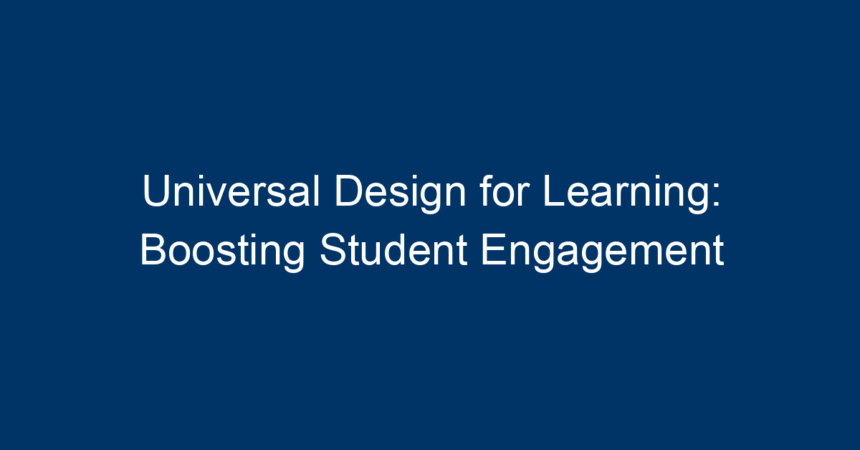In today’s diverse educational landscape, fostering student engagement has never been more critical. Traditional teaching methods, which often cater to a narrow spectrum of learning styles, can leave many students feeling disconnected or overwhelmed. Enter Universal Design for Learning (UDL)—a framework focused on providing all students with equal opportunities to learn. By understanding and implementing UDL principles, educators can create an inclusive environment that promotes active participation and engagement. This article explores the tenets of UDL, its significance in enhancing student engagement, and actionable strategies for implementation.
Understanding Universal Design for Learning
Universal Design for Learning is rooted in the belief that every learner is unique and has varied needs. Developed by the CAST organization, UDL provides a set of guidelines to create flexible learning experiences tailored to individual differences. The framework is built on three core principles:
- Multiple Means of Representation
- Multiple Means of Action and Expression
- Multiple Means of Engagement
By integrating these principles, educators can design curricula that resonate with all students, making learning more accessible and enjoyable.
The Importance of UDL in Contemporary Education
The importance of UDL cannot be overstated. As classrooms become more diverse, the traditional "one-size-fits-all" approach fails to address the complexities of individual learning styles. UDL helps mitigate barriers in learning environments, ensuring that every student—regardless of their background—has the opportunity to thrive. When learning is accessible and engaging, students are more likely to participate actively, leading to improved academic outcomes and a more enriching educational experience.
How UDL Boosts Student Engagement
1. Personalization of Learning Experiences
Personalization is at the heart of UDL. Through UDL, educators can provide students with varied pathways to learn and demonstrate their understanding. For instance, some students may excel through visual aids, while others might benefit more from hands-on activities or auditory materials.
- Actionable Insight: Implement choice boards that allow students to select from different formats for assignments—like videos, presentations, or written reports—to showcase their understanding.
2. Increased Motivation
A key tenet of UDL is to enhance student motivation by making learning relevant and engaging. When students see the relevance of what they’re learning to their lives or future careers, they are more likely to invest time and effort.
- Actionable Insight: Integrate real-world problems into lessons and project-based learning activities. For example, a math lesson on budgeting can revolve around planning a class event, thereby connecting the academic content to students’ interests.
3. Active Participation and Collaboration
UDL encourages collaboration among students, which fosters a sense of community and belonging. Peer interactions can enhance the learning experience by allowing students to share insights, ask questions, and provide support.
- Actionable Insight: Use collaborative tools and platforms, such as Google Classroom or Padlet, to facilitate teamwork and discussion. Assign group projects that require students to utilize their unique strengths.
4. Flexibility in Learning Environments
Learning doesn’t have to take place in a traditional classroom setting. UDL promotes flexibility in physical spaces. Students may engage better in less conventional environments, like outdoor classrooms or quiet zones.
- Actionable Insight: Redesign classroom layouts to accommodate different activities—students can work at desks, in small groups, or even in open areas with appropriate resources tailored to their learning styles.
Implementing UDL in the Classroom: Step-by-Step Guide
Step 1: Assess Learner Needs
Begin by understanding the specific needs and preferences of your students. Use surveys or focus groups to gauge learning styles, interests, and potential barriers.
Step 2: Design Flexible Learning Goals
Establish learning goals that accommodate a range of abilities. Instead of rigid objectives, create more comprehensive, inclusive goals that allow for various pathways to achievement.
Step 3: Create Varied Materials and Resources
Develop or source diverse resources—videos, readings, interactive activities—that cater to different learning preferences.
Step 4: Foster an Inclusive Culture
Promote a classroom culture that embraces diversity and encourages collaboration. Set expectations that reinforce respect, empathy, and support among students.
Step 5: Evaluate and Iterate
Regularly assess the effectiveness of your UDL strategies. Gather feedback from students and be willing to make adjustments as necessary.
Success Stories: UDL in Action
Many schools have successfully implemented UDL principles, leading to remarkable improvements in student engagement and performance. For instance, a high school in New York revamped its curriculum using UDL strategies, resulting in heightened participation rates, particularly among students with learning disabilities.
Case Study: A Middle School Transformation
At a middle school in Texas, educators adopted UDL principles to promote engagement in their science curriculum. They integrated virtual simulations, hands-on experiments, and collaborative projects to appeal to diverse learning styles. The outcome? A significant increase in enthusiasm for science classes, an uptick in test scores, and heightened interest in STEM-related fields.
Overcoming Challenges in UDL Implementation
While the benefits of UDL are clear, integrating this framework into existing curricula can present challenges.
1. Training and Resources
Educators may lack familiarity with UDL principles. Providing professional development opportunities can foster a deeper understanding.
- Actionable Insight: Organize workshops focused on UDL. Utilize resources from CAST or the UDL-IRN to foster knowledge sharing.
2. Time Constraints
Teachers often face tight schedules that inhibit the exploration of new strategies.
- Actionable Insight: Advocate for institutional support to integrate UDL planning into professional learning communities (PLCs) or faculty meetings, allowing teachers to collaboratively develop UDL-based initiatives.
3. Limited Resources
Schools in lower socioeconomic areas may lack access to diverse tools and technologies.
- Actionable Insight: Explore grants or partnerships with organizations that support educational initiatives. Use free online resources to provide varied learning materials.
Conclusion: The Future of UDL in Education
Universal Design for Learning is not merely a teaching framework; it’s a profound commitment to inclusivity and accessibility in education. By prioritizing student engagement through flexible learning experiences, we can empower all learners to become active participants in their education.
As educators, the responsibility lies with us to embrace UDL principles and advocate for a systemic change that values every student’s unique learning journey. Start today by assessing your classroom practices and taking small steps to integrate UDL. The future of education is inclusive, engaging, and transformative—let’s make it a reality together!




